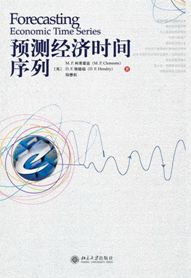 预测经济时间序列
预测经济时间序列
Forecasting Economic Time Series
作者:M. P. 柯莱蒙兹(Clements),D. F. 韩德瑞(Hendry),陆懋祖
定价:55.00元
ISBN:978-7-301-13235-7/F•1816
出版日期:2008-01
卜算未来是一门既古老又受人尊重的行业。我们的祖先很早就已经知道如何根据季节的变化,预计渔汛的大小、安排庄稼的种植和收割等,甚至能估算迁徙的鸟群过往的时间。在古代希腊,岱尔斐 (Delphi*) 的女教士就能为当时的皇帝和达官显贵卜算未来;而在中国,早在殷商时代,人们已将对将来的预测刻在龟背上,有些至今尚存。
从上个世纪后半期至今,对经济时间序列的预测,在方法的数量和规模上都有稳步的发展。有些这样的方法在很大程度上依赖经济学理论,以此构造预测模型;而有些则采用各种不同的统计和时间序列模型。随着数据资料的日渐丰富,和计算技术的突飞猛进,我们可使用的模型也快速地日益增加。这就使得比较和评价不同预测技术和方法显得更为重要,目的当然是最终选取最好的预测方法或模型。
但这完全不表明经济的现状和未来是容易预测的。事实上,由于市场结构和预测长度的特殊性,对某些经济部门的预测是相当困难的。我们有时甚至无法判断,我们对经济的预测的质量是否比过去有了实质性的提高,因为在过去的几十年中经济发展的速度加快,国家间的贸易也成倍增加,经济结构也由此经常发生变化,这就大大地提高了预测的难度。
预测一旦形成,一般都为决策者所用,而好的预测常可引起好的决策。决策的利弊决定于预测的质量,也依赖于所预测变量最终出现的值。但我们必须注意到,在有些情况下,预测可以反过来影响被预测变量以后出现的实际值。最典型的例子,是决策者将预测作为决定将来政策的基础。显然,预测评价在这样的情况下更为复杂。
随着时间的迁移,预测者将不断地探索新的和更复杂的预测技术,如采用含有更多解释变量的模型,它们甚至可以有非线性形式和随时间变化的参数,还需用诸如卡尔曼滤波方法等作估计。然而,这些新技术并不能保证我们取得更好的预测。
预测的形成过程过去是,现在和将来仍将是令人振奋的科研领域,它将不断地产生新的技术和方法,并应用于新领域中新的时间序列。这本书为研究者和学生提供了这样的机会,使他们能带着信心进入这一充满希望的领域,并得到理性上的享受。
C.W.J. 格兰杰
2003 年诺贝尔经济奖得主
2005年10月于加州大学圣地亚哥分校
注:序言名字为编者加。
* 岱尔斐 (Delphi) 位于雅典西北一百英里处,是古代希腊的宗教圣地,著名的阿波罗神殿亦在此。岱尔斐已被现代科学借用,岱尔斐预测技术现指一种专家体系的预测方法 (作者注)。
格兰杰爵士序的英文原文
Looking into the future is a very ancient and honorable procedure. Our earliest ancestors learnt how to judge when the seasons would change so that crops should be planted, fish would be plentiful, or when migrating herds would pass some local point. In ancient Greece the female priests in Delphi would foretell the future for kings and others, and in China’ Yin and Shang dynasties people carved forecasts into turtle shells, some of which still exists.
During the second half of the twentieth century and more recently the methods of forecasting economic series have steadily developed in scope and expanded in number. Some techniques make strong use of economic theory to structure the model whereas others consider a variety of alternative statistical, time series models. As data becomes more plentiful and computing more powerful, the range of possible models is rapidly expanding. This makes the comparison and evaluation of the alternatives more important, but the eventual procedures chosen should be superior.
This does not imply that the economy is easy to forecast; many parts remain very difficult depending on the type of market and on the forecast horizon being considered. It is not even clear if forecasts are improving in quality as the economy is evolving over time, changing its structure as institutions evolve and as trading between countries increases, for example.Once formed, the forecast has to be used, presumably by a decision maker. In general, a superior forecast should lead to better decisions. The value achieved by the decision will depend on the quality of the forecast and on the actual value that occurs for the variable of interest. In some cases the situation is made more complicated because the forecast can influence the actual variable; that is the value that is being forecast. This can occur if a policy maker takes the forecast into account when deciding on the policy. Evaluation is clearly more difficult in these cases.
As time passes forecasters will continue to continue to consider new, and probably more complicated, techniques including more explanatory variables, nonlinear forms or those with time-varying parameters, possibly estimated using a Kalman Filter. There is no guarantee that these new techniques will produce superior forecasts.
The formation of forecasts remains a continually interesting (and even exciting) activity that can be applied to new series from new sources. Using this book, students and researchers can enter this area with confidence and, hopefully, enjoyment.
Sir Clive Granger
2003 Nobel Prize Laureate in Economics
